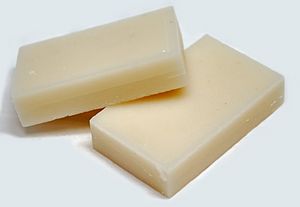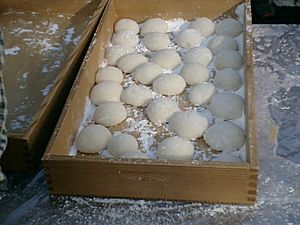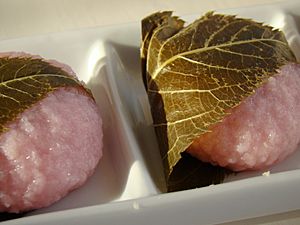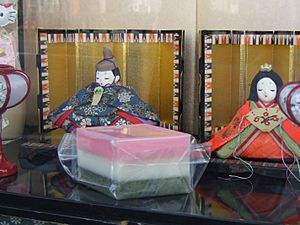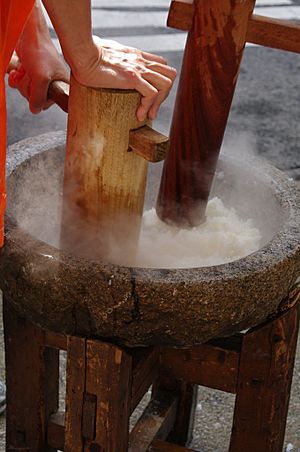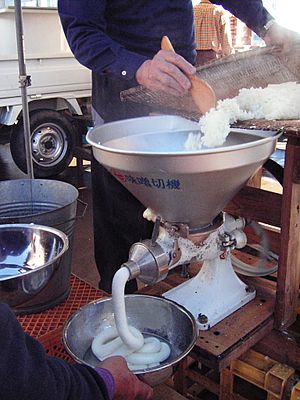Mochi (food) facts for kids
Mochi (Japanese: 餅, もち) is Japanese rice cake made of mochigome, a short-grain japonica glutinous rice. The rice is pounded into paste and molded into the desired shape. In Japan it is traditionally made in a ceremony called mochitsuki. While also eaten year-round, mochi is a traditional food for the Japanese New Year and is commonly sold and eaten during that time.
Mochi is a multicomponent food consisting of polysaccharides, lipids, protein and water. Mochi has a heterogeneous structure of amylopectin gel, starch grains, and air bubbles. This rice is characterized by its low level of amylose starch, and is derived from short- or medium-grain japonica rices. The protein concentration of the rice is higher than that of normal short-grain rice, and the two also differ in amylose content. In mochi rice, the amylose content is negligible, and the amylopectin level is high, which results in its gel-like consistency.
Contents
History and origin
The exact origin of mochi has yet to be confirmed. The first mochitsuki ceremony occurred after the Kami are said to have descended to Earth, which was following the birth of rice cultivation in Yamato during the Yayoi period (300 BC-300 AD). Red rice was the original variation used in the production of mochi. At this time, it was eaten exclusively by the emperor and nobles due to its status as an omen of good fortune. During the Japanese Heian period (794-1192), mochi was used as a "food for the gods" and in religious offerings in Shinto rituals performed by aristocrats. In addition to general good fortune, mochi was also known as a talisman for happy marriages.
The first recorded accounts of mochi being used as a part of New Year’s festivities are from the Japanese Heian period. The nobles of the imperial court believed that long strands of freshly made mochi symbolized long life and well-being, while dried mochi helped strengthen one’s teeth. Accounts of it can also be found in the oldest Japanese novel, The Tale of Genji.
Mochi continues to be one of the traditional foods eaten around Japanese New Year, as it is sold and consumed in abundance around this time. A special type, called kagami mochi (mirror mochi), is placed on family altars on December 28 each year. Kagami mochi is composed of two spheres of mochi stacked on top of one another, topped with an orange (daidai). On this occasion, which was originally practiced by the samurai, the round rice cakes of kagami mochi would be broken, thus symbolizing the mirror’s opening and the ending of the New Year’s celebrations.
Seasonal specialities
New Year
- Kagami mochi is a New Year decoration, which is traditionally broken and eaten in a ritual called kagami biraki (mirror opening).
- Zōni is a soup containing rice cakes. It is also eaten on New Year's Day. In addition to mochi, zoni contains vegetables such as taro, carrot, honeywort, and red and white colored kamaboko.
- Kinako mochi is traditionally made on New Year's Day as an emblem of luck. This style of mochi preparation involves roasting the mochi over a fire or stove, then dipping it into water, finally coating it with sugar and kinako (soy flour).
Spring time
The cherry blossom (sakura), is a symbol of Japan and signifies the onset of full-fledged spring. Sakuramochi is a pink-coloured mochi surrounding sweet anko and wrapped in an edible, salted cherry leaf; this dish is usually made during the spring.
Children's Day
Children's Day is celebrated in Japan on May 5. On this day, the Japanese promote the happiness and well-being of children. Kashiwa-mochi and chimaki are made especially for this celebration. Kashiwa-mochi is white mochi surrounding a sweet anko filling with a Kashiwa oak leaf wrapped around it. Chimaki is a variation of a dango wrapped in bamboo leaves.
Girls' Day
Hishi mochi is a ceremonial dessert presented as a ritual offering on the days leading up to Hinamatsuri or "Girls' Day" in Japan. Hishi mochi] is rhomboid-shaped mochi with layers of red, green, and white. The three layers are coloured with jasmine flowers, water caltrop, and mugwort.
Traditional preparation
Traditionally, mochi was made from whole rice, in a labor-intensive process. The traditional mochi-pounding ceremony in Japan is mochitsuki:
- Polished glutinous rice is soaked overnight and steamed.
- The steamed rice is mashed and pounded with wooden mallets (kine) in a traditional mortar (usu). The work involves two people, one pounding and the other turning and wetting the substance the mochi. They must keep a steady rhythm or they may accidentally injure each other with the heavy kine.
- The sticky mass can be eaten immediately or formed into various shapes (usually a sphere or cube).
Modern preparation
Mochi is prepared from a flour of sweet rice (mochiko). The flour is mixed with water and cooked on a stovetop or in the microwave until it forms a sticky, opaque, white mass. This process is performed twice, and the mass is stirred in between until it becomes malleable and slightly transparent.
With modern equipment, mochi can be made at home, with the technology automating the laborious dough pounding. Household mochi appliances provide a suitable space where the environment of the dough can be controlled.
The assembly-line sections in mochi production control these aspects:
- Viscoelasticity or the products' chewiness by selecting specific species of rice
- Consistency of the dough during automated pounding process
- Size
- Flavourings and fillings
Varieties of glutinous and waxy rice are produced as major raw material for mochi. The rice is chosen for tensile strength and compressibility. One study found that in Kantomochi rice 172 and BC3, amylopectin distribution varied and affected the hardness of mochi. Kantomochi rice produced harder, brittle, grainy textures, all undesirable qualities except for ease of cutting. For mass production, the rice variety should be chewy, but easy to separate.
Generally, two types of machines are used for mochi production in an assembly line. One machine prepares the dough, while the other forms the dough into consistent shapes, unfilled or with filling. The first type of machine controls the temperature at which the rice gelatinizes. One study found that a temperature of 62°C corresponds to the gelatinization of mochi. When the temperature fell below 62°C, the hardening was too slow. It was concluded that a processing temperature below 62 °C was unsuitable for dough preparation.
Processing
Mochi is a variation of a low-calorie, low-fat rice cake. The cake has two essential raw materials, rice and water. Sticky rice (also called sweet rice, Oryza sativa var. glutinosa, glutinous sticky rice, glutinous rice, waxy rice, botan rice, biroin chal, mochi rice, pearl rice, and pulut), whether brown or white, is best for mochi-making, as long-grain varieties will not expand perfectly. Water is essential in the early stages of preparation. Other additives such as salt and other seasonings and flavourings are important in terms of nutritive value and taste. However, additives can cause breakage of the mass, so should not be added to the rice before the cake is formed. The cake must be steamed (rather than boiled) until it gains a smooth and elastic texture. The balls of rice are then flattened, cut into pieces, or shaped into rounds. The machines for mass production are a hugely expensive investment, and the product should have the proper moisture, to appeal to consumers.
The manufacturing process of mochi is:
- The first step is to sprout the rice, which can be done using the soaking method or the humidity method. The soaking method involves soaking rice in water until the desired moisture level is attained (for example 10 kg of rice are soaked for 6–12 hours). The final soaked rice volume should be 50% greater than the dried rice. In the humidity method, the rice is circulated in a device similar to a grain dryer. The device blows warm and moist air onto the rice.
- After sprouting, the rice should be dried. For this step, a mechanical dryer or heated environment is essential. Usually, a temperature of 38–82°C is used. Drying time depends on factors such as rice quantity, chemical composition, and the temperature of the environment.
- The next step is roasting. The soaked and dried rice is roasted with an oven or a mechanical roaster. The rice is then transferred on long trays about 1.3 cm deep to a 90–200°C environment for 30–60 minutes or until the rice become light brown.
- After being roasted, the rice is placed in an environment below 27°C to cool.
- The cooled rice is then ground by a roller mill, burr mill, attrition mill, disintegrator mill, or hammer mill.
- The rice flour is then placed in the rice cake machine. Each manufacturer has about 80-90 machines, and each machine has one to three cooking heads which make one mochi cake every 15 seconds.
- The rice flour should be soaked to a liquid. Different kinds of mochi are soaked in different types of liquids such as water, milk, broth, juice, gravy, or plant milk (such as soy and almond).
- The soaked rice flour is then placed into the hoppers which are located above the machines.
- The soaked rice flour is removed from hoppers to the iron molds or cooking head in the machines by gravity force. The molds are then heated.
- While the molds are heated, the plates are opened and the molds exposed to a vacuum (a combination of heat and pressure).
- After 8–10 seconds, the lids of the molds expand so that the pressure increases. At the end of the process of the combination of pressure and temperature, the cake has completely expanded into the molds.
- Once the desired expansion of molds is acquired, the iron molds/cooking heads open, allowing the rice cakes to fall softly onto the conveyor belt.
- The belt carries the cakes around spraying heads, where different flavours and additives are sprayed onto them. The flavours determine the different types of mochi. However, natural flavours are usually preferred (salt, strawberry, mango, blueberry, apple cinnamon, caramel, almond, salsa, nacho, taco, and tamari seaweed).
- After the addition of different flavours, the cakes are carried to the dryer tunnel by the belt. In the dryer tunnel, the moisture of the rice cakes is reduced.
- At the last stage, the belt moves the finished mochi to the bagging area. In the bagging area, the cakes are inspected carefully for any breakage or damage, then stacked, packaged, sealed, and labelled.
Preservation
The best preservation for mochi is refrigeration for a short storage period. For preserving larger batches over an extended time, freezing is recommended. The best method for freezing involves wrapping each mochi cake tightly in a sealed plastic bag. Although mochi can be kept in a freezer for almost one year, the frozen mochi may lose flavor and softness or get freezer-burned.
Images for kids
See also
 In Spanish: Mochi para niños
In Spanish: Mochi para niños


